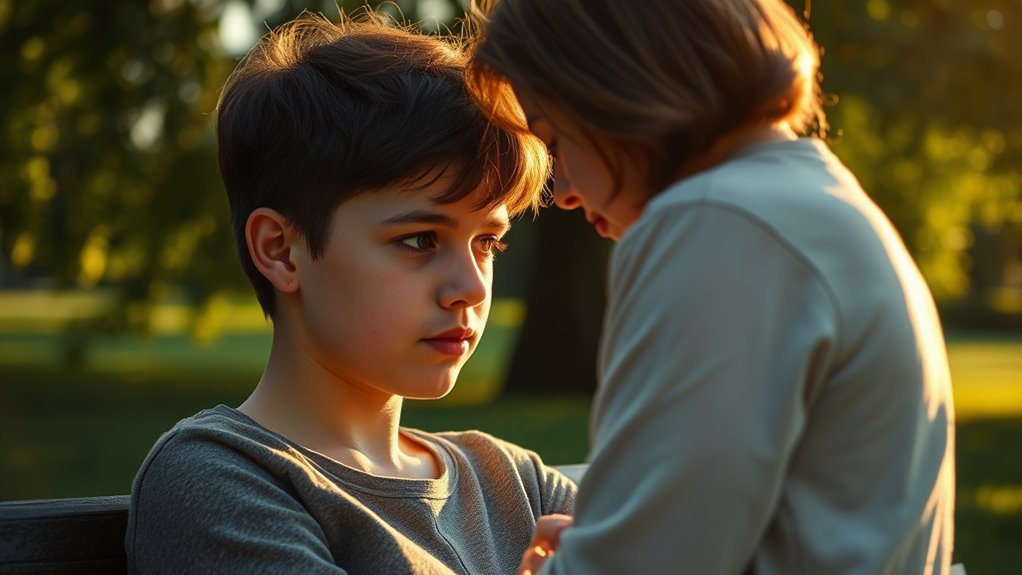The ‘favorite person’ dynamic in BPD describes a deep emotional bond where you rely heavily on one person for validation, stability, and support. This connection often involves intense attachment, fear of abandonment, and mood swings based on their actions or distance. You may cling tightly and prioritize their needs, feeling lost or worthless without them. Understanding this pattern helps you see it as part of the disorder, and if you keep exploring, you’ll learn ways to manage it better.
Key Takeaways
- The ‘favorite person’ is a central emotional anchor, providing validation and security for someone with BPD.
- It stems from fears of abandonment, leading to intense attachment and dependency.
- The dynamic involves mood swings, clinginess, and seeking constant reassurance from the favorite person.
- It can cause emotional turbulence, with feelings of euphoria or devastation based on the relationship’s status.
- Understanding this pattern helps in fostering compassion and developing healthier relationship boundaries.

Have you ever wondered what it means to have a “favorite person” in borderline personality disorder (BPD)? If you’re familiar with BPD, you’ve probably heard this term thrown around. It’s a unique and intense relationship dynamic that can feel both deeply meaningful and painfully overwhelming. When someone with BPD identifies their favorite person, they often see this individual as an essential source of stability, validation, and emotional support. That person becomes their anchor, someone they rely on heavily, sometimes to the point of obsession. It’s not just about liking someone; it’s about forming an intense emotional bond that can dominate their thoughts and feelings.
This favorite person relationship is rooted in a deep fear of abandonment and instability. People with BPD often struggle with trusting others and feeling secure in relationships. When they find someone they connect with strongly, they cling to that person because, in their mind, they’ve found someone who understands and accepts them unconditionally. However, this attachment can quickly turn into dependency. They might constantly seek reassurance, crave contact, and become upset if they perceive even a small threat to the relationship. Their emotions can swing wildly—feeling euphoric when they’re close to their favorite person and devastated if they sense distance or rejection.
You might notice that the favorite person becomes a central figure in their world. They might prioritize that person’s needs over their own, and their mood can hinge on the other’s actions or words. It’s almost as if their sense of self becomes intertwined with this individual. This can lead to intense jealousy, fear of losing the favorite person, or even feelings of worthlessness if that person seems distant. Because of these dynamics, the relationship can feel all-consuming, and the person with BPD might struggle to maintain boundaries or see the relationship objectively. The favorite person often bears a significant emotional burden, sometimes feeling overwhelmed or manipulated by the intensity of the connection.
Understanding this dynamic is essential because it highlights how vulnerable people with BPD can be in their relationships. It’s not just about overattachment—it’s about trying to fill an emotional void caused by fears of abandonment and feelings of emptiness. Recognizing the patterns can help both the individual and their loved ones navigate this relationship more compassionately. It’s essential to remember that this isn’t a choice but a symptom of the disorder, driven by a desperate need for security and acceptance. Additionally, practicing self-awareness can help individuals better understand their emotional responses and reduce impulsive behaviors, fostering healthier relationships. Knowing this can foster patience, empathy, and better support for someone living with BPD and their favorite person relationship.
Frequently Asked Questions
How Does the Favorite Person Dynamic Develop in BPD?
You develop the favorite person dynamic in BPD when you seek intense connection and reassurance from someone. This often happens after feeling abandoned or insecure, causing you to cling to that person for stability. As your attachment deepens, you might idealize them, fearing loss or rejection. This push-and-pull cycle can intensify your dependence, making the person your primary emotional anchor, even if it becomes overwhelming or unhealthy.
Can the Favorite Person Change Over Time?
Yes, your favorite person can change over time. As you grow and work through your emotions, your attachment shifts based on your experiences and healing progress. You might find yourself drawn to someone new or develop a different connection that feels more stable. Be patient with yourself, and remember that these changes reflect your evolving needs and understanding, helping you build healthier relationships in the long run.
What Are the Risks of Dependency on a Favorite Person?
Relying heavily on your favorite person is like anchoring your ship in a stormy sea—you risk losing your stability if they’re no longer there. Dependency can trap you in a cycle of fear and insecurity, making it hard to navigate life’s waves independently. It’s essential to build your own compass, trusting yourself more, so you don’t become stranded when the tide shifts or the anchor is pulled away.
How Can One Support Someone With a Favorite Person in BPD?
You can support someone with a favorite person in BPD by offering consistent, non-judgmental presence and encouraging healthy boundaries. Listen actively and validate their feelings without trying to fix everything. Remind them of their individual worth outside the relationship, and promote self-care. Be patient and understanding during emotional swings, and avoid taking their reactions personally. Your stability can help create a safe space for their growth and healing.
Is the Favorite Person Relationship Always Unhealthy?
No, the favorite person relationship isn’t always unhealthy, though it often feels that way. You might find yourself craving closeness while fearing abandonment, creating a rollercoaster of emotions. It’s like walking a tightrope—balancing attachment and independence. If you recognize these patterns, you can work toward healthier boundaries. With effort, you can enjoy meaningful connection without losing yourself, proving that even intense bonds can be positive when managed thoughtfully.
Conclusion
Understanding the favorite person dynamic in BPD helps you see how intense attachments form and how they can impact your relationships. Recognizing these patterns allows you to navigate your emotions better and seek healthier connections. Are you ready to break free from the cycle and build stronger, more balanced relationships? Remember, awareness is the first step toward change—and you have the power to create the relationships you truly deserve.









